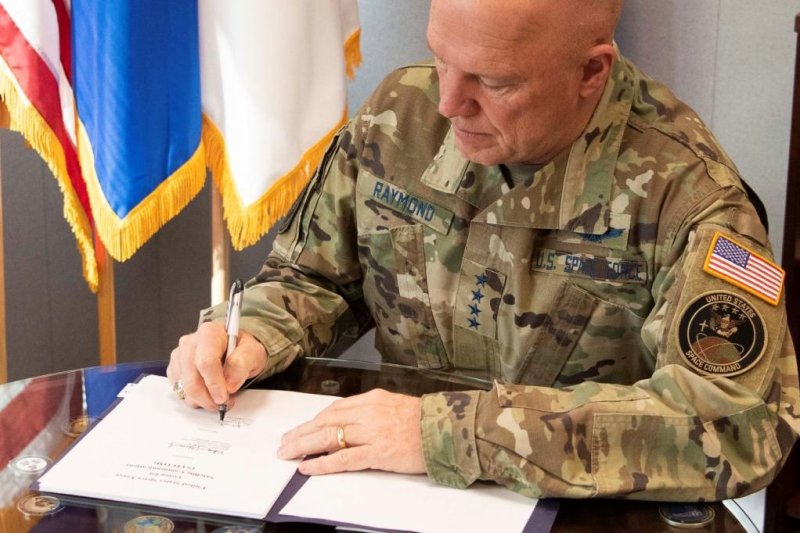Gen. Jay Raymond, Chief of Space Operations, U.S. Space Force, and Commander, U.S. Space Command, signs the USSF Vision for Enterprise Satellite Communications. Photo by Patrick Morrow/U.S. Department of Defense
Feb. 19 (UPI) -- Gen. Jay Raymond has signed the USSF Vision for Enterprise Satellite Communications, according to the Space Force, the branch said on Wednesday.
"We must move faster than our adversaries to ensure warfighters receive the operational benefits of an integrated SATCOM enterprise capable of delivering SATCOM effects in CDO environments. We must adopt faster acquisition processes and faster command and control constructs to maintain the advantage in any conflict," the vision paper states.
The vision, which was written with input from experts from USSF, the Space and Missile Systems Center and Space Force Commercial SATCOM Office, also states that the newly-created branch's SATCOM needs to be a single system that can continue to communicate with warfighters in a contested, degraded and operationally limited environment.
Raymond's signing of the vision paper comes a little more than a week after he said Space Force was watching two Russian satellites that appear to be observing a U.S. satellite at close range -- behavior he described as "unusual and disturbing."
"Despite the global, instantaneous reach of our satellite communications systems, which includes both military and commercial capabilities, the current loose federation of SATCOM systems needs to improve in resiliency, robustness, flexibility, and manageability," Maj. Gen. Bill Liquori, USSF Director of Strategic Requirements, Architectures and Analysis, said in a statement.
The single, integrated SATCOM structure is intended to enhance integration between the military and private sectors, the branch said.
The signing of the vision paper is the culmination of efforts to transfer and streamline satellite communications in the armed forces.
In December 2018, Air Force Space Command assumed sole responsibility for COMSATCOM services on behalf of the Pentagon. In May 2019 the secretaries of the Air Force and Navy agreed to transfer responsibility for the future narrowband capacity from the Navy to the Air Force to consolidate space capabilities.
And, in December 2019, Air Force Space Command was re-designated as the U.S. Space Force, which -- according to the branch's announcement of the vision -- allows the branch new acquisition authorities.
In January, the Pentagon's chief acquisitions officer said the speed of space-related acquisitions was unlikely to slow even as the Pentagon restructures its acquisitions structure.
So far, the new branch has wrapped a flag exercise that began before its official creation and reassigned 6,000 Air Force Space Command troops to its ranks, as well as starting the process of transferring personnel from other branches, with the goal of a 16,000-strong force once all transfers are complete.















